
|
Origins / Origen; How to get there / Como llegar allí; The fun begins / Empieza la diversión; My experience at La Tomatina / Mi experiencia a la Tomatina; Videos of la Tomatina / Videos de la Tomatina;
LA TOMATINA - Buñol, Valencia
La Tomatina consists of a massive tomato fight held in the town of Buñol, 38km from Valencia, normally held the last Wednesday of August. Approximately 30,000 people from all over the world arrive early in the morning to fight in the battle in which about 150,000 over-ripe tomatoes are hurled in the streets. Bearing in mind that the normal population of Buñol is 9,000, one can imagine that the town is hurled into chaos for this messy festival. |
La Tomatina es una pelea grande de tomates que tiene lugar en el pueblo de Buñol, 38 km de Valencia, que normalmente occure el último miércoles de agosto. Aproximadamente 30,000 personas vienen de todas partes del mundo por la mañana para luchar en la batalla en la que se tira 150,000 tomates demasiado maduros por las calles. Si se piensa que la populación normal de Buñol es de 9,000, se puede imaginar que el pueblo se convierte en caos para esta fiesta sucia. |
||
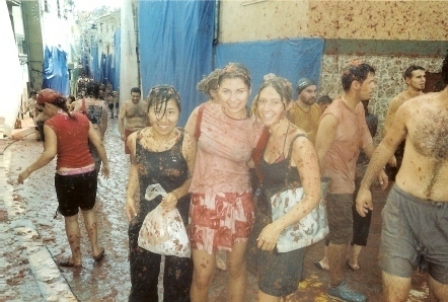 |
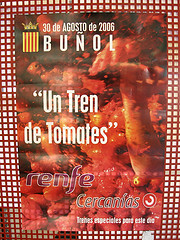 |
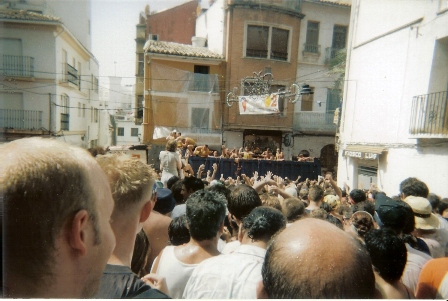 |
| ORIGINS / ORIGEN |
Although La Tomatina has been an annual tradition in Buñol since 1944, the exact origin of the biggest tomato fight in the world is unknown. Some theories are that it started as a food fight among friends, perhaps due to an accidental lorry spillage; a class war; or that habitants attacked the councilmen during a town celebration. Nevertheless, what is sure is that many people joined in the fun and enjoyed it so much that it has been continued every year since. The festival was banned during the dictatorship under Franco, having no political or religious significance; but its success was proven when it returned in the 1970s after the death of Franco. To boost tourism the event has now grown into a weeklong festival, which includes music, parades, dancing and fireworks in town. Furthermore, on the night before La Tomatina, there is a paella cooking contest. |
 |
Aunque La Tomatina ha sido una tradición anual en Buñol desde 1944, no se conoce el origen exacto de la lucha más grande de tomates en el mundo. Algunas piensan que comenzó a causa de una pelea de comida entre amigos, quizás debido a un derramado accidental de un camión; una lucha entre las clases; o que los habitantes atacaron los consejales durante una fiesta del pueblo. No obstante, lo que es seguro es que mucha gente decidieron de juntarse a la diversión y así ha continuado cada año. La fiesta fue prohibida durante la dictadura de Franco, porque no tenía significancia política ni religiosa; pero se demostró su éxito cuando volvió en los años 70 después de la muerte de Franco. Para atraer más turistas ahora la fiesta dura una semana entera, y incluye música, desfiles, bailes y fuegos artificiales en el pueblo. Además, la noche antes de La Tomatina, hay un concurso de cocinar paella. |
 |
| HOW TO GET THERE / COMO LLEGAR ALLI | |||
- from Valencia: (the easiest route) By train with line C-3 with train company Cercanias de Renfe - from Madrid: By car on motorway (Autovia) A-3 Madrid-Valencia |
- desde Valencia: (la manera más fácil) Por tren con línea C-3 con Cercanias de Renfe - desde Madrid: por coche en la autovía A-3 Madrid a Valencia |
||
View Larger Map |
|||
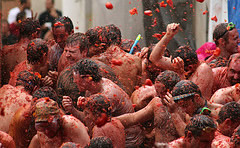 |
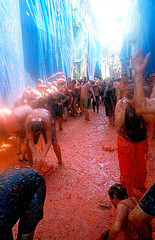 |
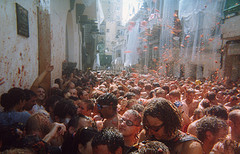 |
After between one or two hours, a second cannon is fired and no more tomatoes must be thrown. The fighters slide their way through the red river of tomato juice to the nearest public shower or local with a hose-pipe. Thoughtful locals also throw freezing cold water from the first floors of their apartments. Whilst the tomato fighters find their way to the Buñol river to attempt to wash off the remains of tomato (though the clothes worn will most likely have to be thrown away!), the locals begin an intensive cleaning session involving fire trucks and hose-pipes, and there is no trace of tomato within a few hours! |
Después de unas horas, se tira un segundo cannon que significa la parada de
tirar tomates. Los luchadores se deslizan en el rojo río de zumo de tomates para
encontrar la ducha pública más cerca o un vecino con un hose-pipe. Vecinos tiran
agua muy fría de los primer pisos de sus apartamentos. Mientrás que los
luchadores de tomates van al río de Buñol para intentar a lavar los restos de
tomates (aunque es muy probable que tendrán que tirar su ropa en la basura), los
vecinos empiezan una sessión intensiva de limpieza, incluyendo camiones de fuego
y hose-pipes. Dentro de unas horas, no hay más residuos de tomate! |
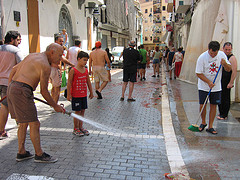 |
 |
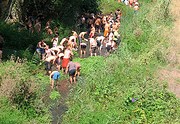 |
|
|
I went to the Tomatina in the summer of 2004 and would recommend the experience to anyone with a mischievous side. After an hour of watching by the sidelines, my friends and I tried to slide nearer to the action and were immediately accosted by a group of young Spanish lads covered in tomatoes. Seeing that we were completely clean, they relished hammering us with tomatoes but we held our own for the last few minutes of battle. Such a bizarre but immensely-fun tradition, it must be seen to be believed! (me far right on this picture)
Yo fui a la Tomatina en el verano de 2004 y recomendaría la experiencia a todos
los que son un poco travieso. Después de una hora de mirar hasta las afueras, yo
y mis amigas intentamos a slide más cerca a la acción y en seguida nos acostaron
un grupo de jovenes españoles que ya estuvieron cubiertos de tomates. Notando
que estuvimos completamente limpias, se relisharon a ambusharnos con tomates,
pero conseguimos a luchar para los últimos minutos de la batalla. Qué tradición
tan rara pero tan divertida - se debe verla para creerla!
(yo a la derecha en la foto) |
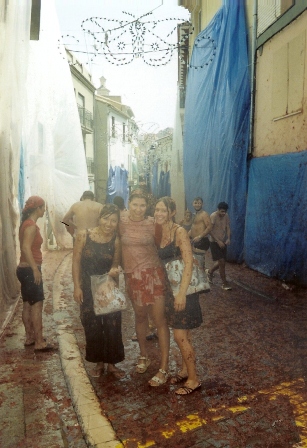 |
| VIDEOS OF LA TOMATINA / VIDEOS DE LA TOMATINA | ||
OTHER SPANISH FIESTAS |
Copyright © and TM 2007-2024 fun-learning-spanish.com